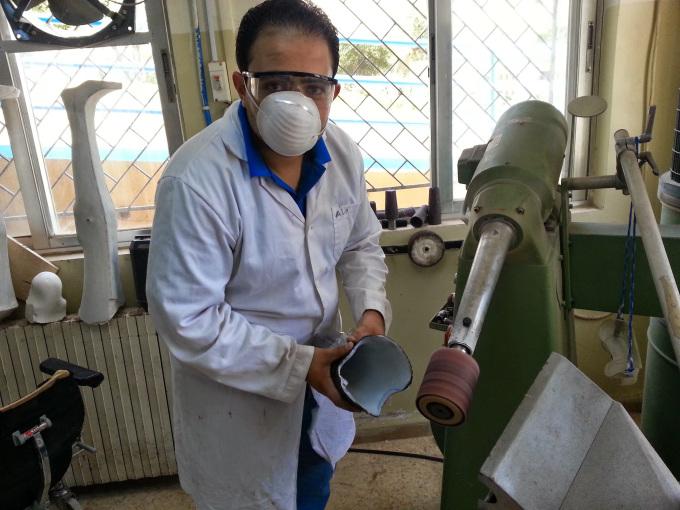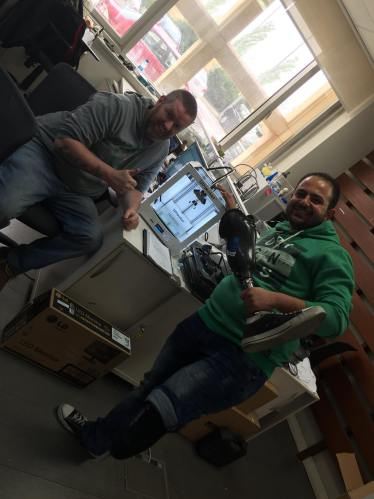After losing his leg, Asem Hasna gained a mission. The 22-year-old volunteer paramedic, only moments after loading injured rebels into an ambulance to take them to receive medical care, lost his own leg to a shell launched by Bashar Al Assad’s military forces. For the first five minutes, Hasna was deafened by the explosion and too stunned to realize he had been seriously injured. The grave nature of his injuries soon became abundantly clear, however, as his leg hemorrhaged and he passed in and out of consciousness.
 His only chance for survival lay in a plan to smuggle him, and 13 other injured people, to Jordan where they could be treated. Due to the circumstances of the ongoing war, the transfer was not just difficult, it was nearly impossible. The trip to Amman was plagued with problems ranging from flying bullets to a total absence of food and water. Two members of the injured group died of their injuries during the journey. Luckily, not only for himself but also for the world, Hasna survived the trip and five subsequent surgeries and then turned his sharp wits toward the production of a wide variety of innovative prosthetic devices designed to help the growing number of those left with devastating injuries.
His only chance for survival lay in a plan to smuggle him, and 13 other injured people, to Jordan where they could be treated. Due to the circumstances of the ongoing war, the transfer was not just difficult, it was nearly impossible. The trip to Amman was plagued with problems ranging from flying bullets to a total absence of food and water. Two members of the injured group died of their injuries during the journey. Luckily, not only for himself but also for the world, Hasna survived the trip and five subsequent surgeries and then turned his sharp wits toward the production of a wide variety of innovative prosthetic devices designed to help the growing number of those left with devastating injuries.
As Hasna undertook his journey to recovery, he became part of a combined effort between the Red Cross and the State Department to train Syrians as prosthetic technicians. This initiative is of vital importance as the number of those injured in the Syrian conflict continues to mount at an alarming rate. It didn’t take long for Hasna to recognize the enormous potential offered through 3D printing technology.
As he explained in an interview with TechCrunch:
“It was weird. I knew how a 2D printer worked but I wanted to find out more about 3D printers and learnt voraciously on the web using open source software. You just have to practice and use your own hands. There’s practical applications using 3D printers for low cost solutions. My world opened up with open source technology. It changed my life for the better and I want to pass that on to the next generation.”
 Hasna was already using a prosthetic leg but found, as do most non-customized prosthetic recipients, that it could use a great deal of improvement. Unlike many other prosthetic users, however, he had a newfound ability to make those adjustments using 3D printing. His first project was to adjust his own limb with the creation of a rubber part to be fit between the heel and the ankle that allowed his leg to achieve a greater degree of stabilization. Working with a 3Dmena, a Jordanian 3D print startup located in Amman, he also created a haptic device that allowed his friend, a young man blinded by sniper fire, to feel vibrations as he walked, providing him with information about the location and depth of objects he encounters.
Hasna was already using a prosthetic leg but found, as do most non-customized prosthetic recipients, that it could use a great deal of improvement. Unlike many other prosthetic users, however, he had a newfound ability to make those adjustments using 3D printing. His first project was to adjust his own limb with the creation of a rubber part to be fit between the heel and the ankle that allowed his leg to achieve a greater degree of stabilization. Working with a 3Dmena, a Jordanian 3D print startup located in Amman, he also created a haptic device that allowed his friend, a young man blinded by sniper fire, to feel vibrations as he walked, providing him with information about the location and depth of objects he encounters.
Unfortunately, the Jordanian government began to crack down on Syrian refugees as it began to feel the strain of having accepted something on the order of a million displaced people, and Hasna had to seek asylum elsewhere. Even more unfortunate is the fact that the journey to do so was one equal in danger to his original flight from Syria. Again finding himself the recipient of a healthy dose of luck, he is currently in Germany awaiting acceptance of his asylum papers…and dreaming of new ways to provide assistance to those in need through 3D printing. Discuss further in the Syrian Technician Makes 3D Printed Prosthetics forum over at 3DPB.com.
[Source/Images: TechCrunch]Subscribe to Our Email Newsletter
Stay up-to-date on all the latest news from the 3D printing industry and receive information and offers from third party vendors.
You May Also Like
Precision at the Microscale: UK Researchers Advance Medical Devices with BMF’s 3D Printing Tech
University of Nottingham researchers are using Boston Micro Fabrication‘s (BMF) 3D printing technology to develop medical devices that improve compatibility with human tissue. Funded by a UK grant, this project...
GaeaStar and Verve Coffee Roasters Start Pilot Production of Sustainable 3D Printed Coffee Cups
Following a 2022 debut in Germany, GaeaStar, a startup based in San Francisco and Berlin, has begun US pilot production of its sustainable, disposable clay cups and bowls made with...
Meltio and Accufacture Unveil Robotic Metal 3D Printer Made in the US
Meltio has partnered with Michigan-based robotics firm Accufacture to introduce Alchemist 1, a robotic cell designed for wire-laser metal 3D printing made in the US. This new system represents a...
WASP Highlights Advances in Healthcare 3D Printing at Italy’s Exposanità 2024
WASP takes center stage at Italy’s leading healthcare expo, Exposanità 2024, demonstrating the transformative impact of its advanced 3D printing technologies on the medical sector. Known for its line of...
































